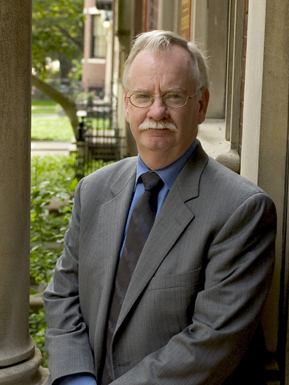Exploring Tougher Town-Gown Times
Three university presidents discuss higher ed and the city

Early on a recent Friday morning, the third floor of Boston’s Federal Reserve Bank is filled with dozens of the region’s most prominent architects, developers, and land-use authorities, folks whose daily work defines our cities’ streetscapes. The business-attired crowd munches on complimentary pastries, sipping coffee. They smile and chat amiably with familiar business acquaintances.
But this group has gathered to hear sobering news from some of their most important customers — Boston area universities.
The Urban Land Institute, a nonprofit real estate research and education organization, is sponsoring this panel discussion with university presidents to assess the recession’s impact on the town-gown dynamic. Paul Grogan, president of the Boston Foundation, moderates as Boston University’s Robert A. Brown, Tufts University’s Lawrence Bacow, and Northeastern University’s Joseph Aoun discuss its various aspects. They talk a lot about money and how everybody — the city, universities, students and their families — has less of it these days.
But the subtext is about something more elusive: value. Do Boston and neighboring cities take universities for granted? How much do universities gain from being in such a vibrant urban area? What’s a university-based concentration of brainpower and community service actually worth? And what are the priorities when money’s tight?
The hour’s discussion barely scratches the surface. But there are noteworthy exchanges.
Grogan starts off with a quick accounting of universities’ contributions to the region’s economy and identity, noting that institutions of higher education bring a quarter of a million young minds into the region every year, employ tens of thousands, and are “the distinctive marker of our community.”
Picking up on that theme, Bacow says he believes universities are “often taken for granted” by Boston and neighboring cities, because of a belief that they’re permanent institutions, in place forever. He acknowledges that being in the Boston area is “a big competitive advantage” for Tufts, but also says that local officials underestimate the intensity of competition for students and top faculty, which makes university costs skyrocket.
Brown agrees. “Our primary focus is attracting the right people, and the amount of money spent to do this is tremendous,” he says, mentioning a range of BU initiatives, from new athletic facilities to working with the city to redevelop Kenmore Square. “I worry that we’ve been driven almost to the valet style of education,” he adds, “which we know is probably not achievable and probably not the right educational goal, either.”
Aoun notes the rise of “no-frills” universities and online degrees, where lower-cost, bare-bones learning is improving in quality. “There are troubling signs that the residential system of higher education, an expensive model built on a strong middle class, is being severely tested,” he says.
Bacow hopes the recession might actually “reset our expectations,” he says, and cause universities to “yet again embrace Yankee thrift.” He notes, with pride rather than regret, that Tufts has no climbing wall or concierge services or campus-wide Wifi.
The three university presidents banter about multiyear capital expenditures and unrealistic financing expectations; the audience responds with knowing murmurs and chuckles. It’s that kind of crowd. On a more serious note, Brown says that universities will need to dip more into their endowments to pay for operations, cutting underwriting for building projects. “The world of hundreds of millions of dollars in new buildings that people envision being funded by endowment growth is probably gone,” he says.
During a question-and-answer period, Brown fields a question from an employee of the Boston Redevelopment Authority about a contentious issue: payments in lieu of taxes (PILOT), which universities and many other land-owning nonprofits voluntarily hand over to cities in exchange for their heavy use of urban infrastructure (as nonprofits, universities do not pay real estate taxes). Local budget crunches have brought renewed calls for universities to contribute more (BU kicks in about $4.6 million a year, the most of any university in the city), and Brown sits on a PILOT task force convened by Boston Mayor Thomas Menino (Hon.’01) late last year.
“We have to come up with a common basis to account for everything universities and other nonprofits contribute to the city at all levels,” he says.
As an example, Brown notes BU’s tradition of providing college scholarships to inner-city high school student through the Boston Scholars Program. This broad capacity for community service is what Aoun refers to as the enormous “human wealth” of universities. “That is our contribution,” to the city, he says. “We should celebrate this.”
And then, the morning still early, cell phones and BlackBerries in hand by the time they reach the elevator, those gathered disband and head to offices all over the city.
Chris Berdik can be reached at cberdik@bu.edu.
Comments & Discussion
Boston University moderates comments to facilitate an informed, substantive, civil conversation. Abusive, profane, self-promotional, misleading, incoherent or off-topic comments will be rejected. Moderators are staffed during regular business hours (EST) and can only accept comments written in English. Statistics or facts must include a citation or a link to the citation.